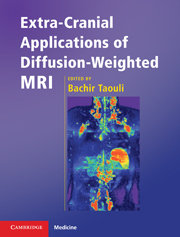Book contents
- Frontmatter
- Contents
- List of contributors
- Preface
- 1 Basic physical principles of body diffusion-weighted MRI
- 2 Diffusion-weighted MRI of the liver
- 3 Diffusion-weighted MRI of diffuse renal disease and kidney transplant
- 4 Diffusion-weighted MRI of focal renal masses
- 5 Diffusion-weighted MRI of the pancreas
- 6 Diffusion-weighted MRI of the prostate
- 7 Breast applications of diffusion-weighted MRI
- 8 Diffusion-weighted MRI of lymph nodes
- 9 Diffusion-weighted MRI of female pelvic tumors
- 10 Diffusion-weighted MRI of the bone marrow and the spine
- 11 Diffusion-weighted MRI of soft tissue tumors
- 12 Evaluation of tumor treatment response with diffusion-weighted MRI
- 13 Diffusion-weighted MRI: future directions
- Index
- References
13 - Diffusion-weighted MRI: future directions
Published online by Cambridge University Press: 10 November 2010
- Frontmatter
- Contents
- List of contributors
- Preface
- 1 Basic physical principles of body diffusion-weighted MRI
- 2 Diffusion-weighted MRI of the liver
- 3 Diffusion-weighted MRI of diffuse renal disease and kidney transplant
- 4 Diffusion-weighted MRI of focal renal masses
- 5 Diffusion-weighted MRI of the pancreas
- 6 Diffusion-weighted MRI of the prostate
- 7 Breast applications of diffusion-weighted MRI
- 8 Diffusion-weighted MRI of lymph nodes
- 9 Diffusion-weighted MRI of female pelvic tumors
- 10 Diffusion-weighted MRI of the bone marrow and the spine
- 11 Diffusion-weighted MRI of soft tissue tumors
- 12 Evaluation of tumor treatment response with diffusion-weighted MRI
- 13 Diffusion-weighted MRI: future directions
- Index
- References
Summary
Introduction
In the last few years, radiology has seen an unprecedented increase in the application of diffusion-weighted magnetic resonance imaging (DWI) for disease assessment in the body. This growing interest in body DWI is reflected by both wider clinical applications and focused research activities, and can be attributed to a greater awareness of the unique imaging information that the technique provides. In many imaging departments, DWI is now integrated into routine imaging protocols, in part to gain experience in applying the technique, but also for the diagnostic information that can be gained from an imaging technique which can be performed very quickly without detrimental effects or impact on the clinical throughput.
The current applications of DWI in the body are largely oncological, and are used in combination with conventional magnetic resonance imaging (MRI) sequences for disease detection and characterization and the assessment of treatment response. Non-oncological applications are also evolving, such as MR neurography, the evaluation of renal function, and the detection of liver fibrosis and cirrhosis. However, as with any new technique, initial enthusiasm often gives way to a more realistic outlook, as the radiological community begins to recognize both the advantages and pitfalls of DWI. Nothing can be more damaging to the widespread adoption and application of a new imaging technique than unsubstantiated claims or unrealistic hype about its potential utility.
What is consistent across centers with greater experience in applying DWI in the body, is the recognition that careful technical optimization is important to achieve the best results.
- Type
- Chapter
- Information
- Extra-Cranial Applications of Diffusion-Weighted MRI , pp. 198 - 210Publisher: Cambridge University PressPrint publication year: 2010



